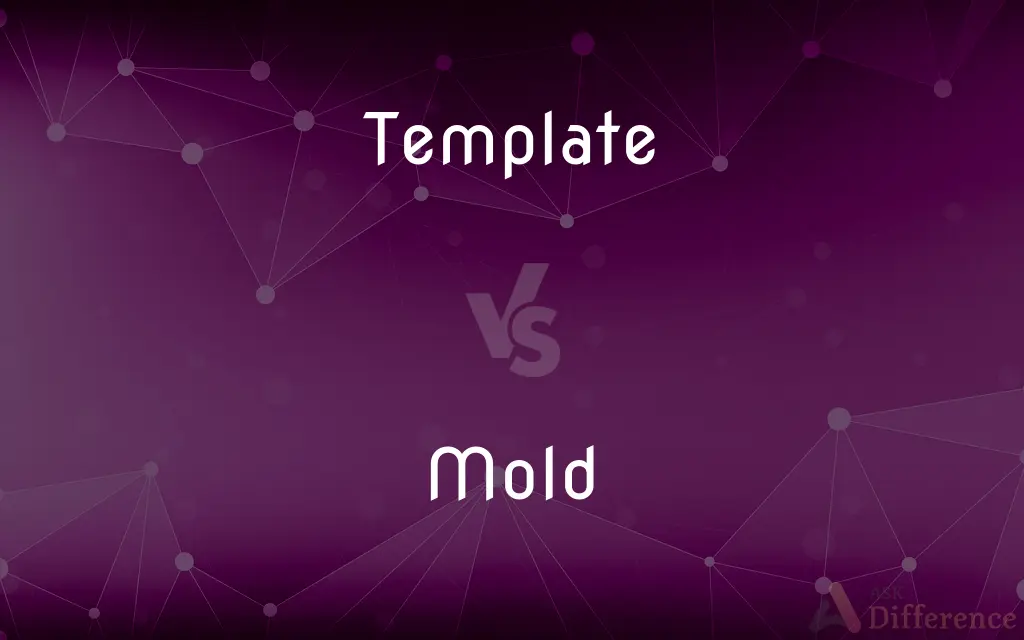Template vs. Mold — What's the Difference?
By Tayyaba Rehman & Urooj Arif — Updated on March 18, 2024
A template is a predesigned model or standard used for structuring or formatting, often in documents or designs, whereas a mold is a hollow container used to give shape to liquid or soft substances that harden into solid forms.

Difference Between Template and Mold
Table of Contents
ADVERTISEMENT
Key Differences
Templates serve as frameworks or blueprints in various fields, including document creation, website design, and software development, providing a predefined structure to ensure consistency and efficiency. Whereas, molds are primarily used in manufacturing and crafting, where materials like plastic, metal, or glass are cast or shaped. Molds are designed to impart precise shapes and textures to materials, transforming them into identical, mass-produced items or unique artistic creations.
The use of templates is common in digital environments, where they facilitate rapid development and standardization, such as in creating business documents, graphic designs, or coding structures. Templates can be customized to some extent but are meant to preserve an overall uniform standard. On the other hand, molds are physical objects often made from materials like silicone, metal, or plaster, used in processes like injection molding, casting, and pottery, where the material poured into the mold takes its shape upon solidification.
Templates are inherently reusable and adaptable, designed to be applied to multiple projects with similar requirements, saving time and resources by eliminating the need to start from scratch for each new project. Molds, while also reusable, are more rigid in their application, as they are designed to produce the same shape repeatedly until a new mold is created for a different design.
In the context of creativity and innovation, templates offer a starting point that can be modified and expanded upon, encouraging a blend of uniformity and customization. Molds, while essential for creating consistent and precise physical objects, might limit creative variation in the shape of the final product, with customization primarily occurring in the finishing stages or through the creation of new molds.
Despite their differences, both templates and molds share the common purpose of standardization and efficiency, each within their respective domains. Templates simplify and expedite the design and development processes, while molds enable the mass production of items with uniform shapes and properties.
ADVERTISEMENT
Comparison Chart
Primary Use
Structuring and formatting in digital or abstract tasks
Shaping materials in manufacturing and crafting
Application
Document creation, web design, software development
Injection molding, casting, pottery
Customization
Adaptable and customizable to some extent
Limited to the design of the mold, less flexible
Material
Digital or conceptual frameworks
Physical materials like silicone, metal, plaster
Purpose
Ensures consistency and efficiency in design
Produces identical physical objects with precise shapes
Reusability
Highly reusable in various projects
Reusable but produces the same shape repeatedly
Compare with Definitions
Template
A predefined format or structure for documents or designs.
The company uses a template for all its business presentations to ensure brand consistency.
Mold
A hollow container used for shaping materials.
The artisan poured the liquid silver into the mold to create the jewelry.
Template
Serves as a blueprint in software development.
Developers use code templates to streamline the creation of new modules.
Mold
Determines the shape and texture of the final product.
The intricate mold design resulted in a beautifully detailed sculpture.
Template
Facilitates rapid content creation in digital media.
Bloggers often use website templates to set up their sites quickly.
Mold
Reusable but produces objects with the same shape.
The chocolate molds are used every Easter to make bunny-shaped treats.
Template
Ensures uniformity and efficiency in creative processes.
Using a newsletter template saves time and maintains a professional appearance.
Mold
Essential in manufacturing for mass-producing identical items.
The factory uses steel molds for injection molding plastic components.
Template
Customizable to fit specific needs within a standard framework.
The report template was customized to include additional analytics sections.
Mold
Can be crafted from various materials based on the casting substance.
For delicate ceramics, a soft plaster mold is often used.
Template
A shaped piece of rigid material used as a pattern for processes such as cutting out, shaping, or drilling.
Mold
A mold (US) or mould (UK, NZ, AU, ZA, IN, CA, IE) is a fungus that grows in the form of multicellular filaments called hyphae. In contrast, fungi that can adopt a single-celled growth habit are called yeasts.
Template
A timber or plate used to distribute the weight in a wall or under a support.
Mold
A town in north-eastern Wales, administrative centre of Flintshire; population 10,500 (est. 2009).
Template
A pattern or gauge, such as a thin metal plate with a cut pattern, used as a guide in making something accurately, as in woodworking or the carving of architectural profiles.
Mold
A hollow form or matrix for shaping a fluid or plastic substance.
Template
A document or file having a preset format, used as a starting point for a particular application so that the format does not have to be recreated each time it is used
A loan amortization template for a spreadsheet program.
Mold
A frame or model around or on which something is formed or shaped.
Template
An overlay that fits over all or part of a keyboard and has labels describing the functions of each key within a particular application.
Mold
Something that is made in or shaped on a mold.
Template
A horizontal piece of stone or timber used to distribute weight or pressure, as over a door frame.
Mold
The shape or pattern of a mold.
Template
(Biochemistry) A molecule of a nucleic acid, such as DNA, that serves as a pattern for the synthesis of a macromolecule, as of RNA.
Mold
General shape or form
The oval mold of her face.
Template
A physical object whose shape is used as a guide to make other objects.
Mold
Distinctive character or type
A leader in the mold of her predecessors.
Template
A generic model or pattern from which other objects are based or derived.
Mold
A fixed or restrictive pattern or form
A method of scientific investigation that broke the mold and led to a new discovery.
Template
(computing) document template file with a basic outline for a work
Mold
(Architecture) See molding.
Template
(molecular biology) A macromolecule which provides a pattern for the synthesis of another molecule.
Mold
Any of various filamentous fungi that grow on and contribute to the decay of organic matter.
Template
A partially defined class or function, that can be instantiated in a variety of ways depending on the instantiation arguments.
Mold
A growth of such fungi.
Template
A strip of metal used in boiler-making, pierced with a series of holes, and serving as a guide in marking out a line of rivet-holes.
Mold
Any of various other saprophytic or parasitic organisms that resemble fungi, such as slime molds or water molds.
Template
To set up or mark off using a template.
Mold
Loose friable soil, rich in humus and fit for planting.
Template
To provide a template or pattern for.
Mold
The earth; the ground.
Template
Same as Templet.
Mold
The earth of the grave.
Template
A model or standard for making comparisons
Mold
(Archaic) Earth as the substance of the human body.
Mold
To form (something) out of a fluid or plastic material
Molded a cup out of clay.
Mold
To form into a particular shape; give shape to
Molded the clay into a ball.
Mold
To guide or determine the growth or development of; influence
A teacher who helps to mold the minds of his students.
Mold
To fit closely by following the contours of (the body). Used of clothing.
Mold
To assume a certain shape
Shoes that gradually molded to my feet.
Mold
To become moldy.
Mold
A hollow form or matrix for shaping a fluid or plastic substance.
Mold
A frame or model around or on which something is formed or shaped.
Mold
Something that is made in or shaped on a mold.
Mold
The shape or pattern of a mold.
Mold
General shape or form.
The oval mold of her face
Mold
Distinctive character or type.
A leader in the mold of her predecessors
Mold
A fixed or restrictive pattern or form.
His method of scientific investigation broke the mold and led to a new discovery.
Mold
(architecture) A group of moldings.
The arch mold of a porch or doorway;
The pier mold of a Gothic pier, meaning the whole profile, section, or combination of parts
Mold
(anatomy) A fontanelle.
Mold
A natural substance in the form of a woolly or furry growth of tiny fungi that appears when organic material lies for a long time exposed to (usually warm and moist) air.
Mold
A fungus that creates such colored, furry growths.
Mold
Loose friable soil, rich in humus and fit for planting.
Mold
Earth, ground.
Mold
The top or crown of the head.
Mold
(transitive) To shape in or on a mold; to form into a particular shape; to give shape to.
Mold
(transitive) To guide or determine the growth or development of; influence
Mold
(transitive) To fit closely by following the contours of.
Mold
(transitive) To make a mold of or from (molten metal, for example) before casting.
Mold
(transitive) To ornament with moldings.
Mold
(intransitive) To be shaped in or as if in a mold.
These shoes gradually molded to my feet.
Mold
(transitive) To cause to become moldy; to cause mold to grow upon.
Mold
(intransitive) To become moldy; to be covered or filled, in whole or in part, with a mold.
Mold
To cover with mold or soil.
Mold
A spot; a blemish; a mole.
Mold
Crumbling, soft, friable earth; esp., earth containing the remains or constituents of organic matter, and suited to the growth of plants; soil.
Mold
Earthy material; the matter of which anything is formed; composing substance; material.
The etherial mold,Incapable of stain.
Nature formed me of her softest mold.
Mold
A growth of minute fungi of various kinds, esp. those of the great groups Hyphomycetes, and Physomycetes, forming on damp or decaying organic matter.
Mold
The matrix, or cavity, in which anything is shaped, and from which it takes its form; also, the body or mass containing the cavity; as, a sand mold; a jelly mold.
Mold
That on which, or in accordance with which, anything is modeled or formed; anything which serves to regulate the size, form, etc., as the pattern or templet used by a shipbuilder, carpenter, or mason.
The glass of fashion and the mold of form.
Mold
Cast; form; shape; character.
Crowned with an architrave of antique mold.
Mold
A group of moldings; as, the arch mold of a porch or doorway; the pier mold of a Gothic pier, meaning the whole profile, section, or combination of parts.
Mold
A fontanel.
Mold
A frame with a wire cloth bottom, on which the pump is drained to form a sheet, in making paper by hand.
Mold
To cover with mold or soil.
Mold
To cause to become moldy; to cause mold to grow upon.
Mold
To become moldy; to be covered or filled, in whole or in part, with a mold.
Mold
To form into a particular shape; to shape; to model; to fashion.
He forgeth and moldeth metals.
Did I request thee, Maker, from my clayTo mold me man?
Mold
To ornament by molding or carving the material of; as, a molded window jamb.
Mold
To knead; as, to mold dough or bread.
Mold
To form a mold of, as in sand, in which a casting may be made.
Mold
The distinctive form in which a thing is made;
Pottery of this cast was found throughout the region
Mold
Container into which liquid is poured to create a given shape when it hardens
Mold
Loose soil rich in organic matter
Mold
The process of becoming mildewed
Mold
A fungus that produces a superficial growth on various kinds of damp or decaying organic matter
Mold
Sculpture produced by molding
Mold
Form in clay, wax, etc;
Model a head with clay
Mold
Become moldy; spoil due to humidity;
The furniture molded in the old house
Mold
Form by pouring (e.g., wax or hot metal) into a cast or mold;
Cast a bronze sculpture
Mold
Make something, usually for a specific function;
She molded the riceballs carefully
Form cylinders from the dough
Shape a figure
Work the metal into a sword
Mold
Fit tightly, follow the contours of;
The dress molds her beautiful figure
Mold
Shape or influence; give direction to;
Experience often determines ability
Mold public opinion
Common Curiosities
Are molds only used for mass production?
While molds are commonly used for mass production due to their ability to produce identical items efficiently, they can also be used for creating unique, one-of-a-kind artistic pieces.
What types of materials can be used in molds?
Various materials, including plastics, metals, glass, and ceramics, can be used in molds, depending on the desired properties and the manufacturing process.
How does a mold work in manufacturing?
In manufacturing, a mold works as a hollow container into which a liquid or malleable material is poured or injected. As the material hardens, it takes the shape of the mold, creating a solid object.
Can templates be customized?
Yes, templates can often be customized to some extent, allowing for alterations in design, content, and structure while maintaining an overall standard framework.
How do templates contribute to efficiency in work processes?
Templates contribute to efficiency by eliminating the need to start from scratch for each new project, providing a standardized starting point that can be quickly adapted to specific needs.
What factors should be considered when choosing a template?
Factors to consider include the purpose of the project, the desired level of customization, the specific features or elements needed, and compatibility with the tools or platforms being used.
What is the primary function of a template?
The primary function of a template is to provide a predesigned framework or standard for creating documents, designs, or structures, ensuring consistency and efficiency.
Can the use of templates stifle creativity?
While templates provide a standardized structure, they still offer flexibility for customization and creativity within the given framework, depending on how they are used.
In what industries are molds commonly used?
Molds are commonly used in industries such as manufacturing, crafting, ceramics, metalworking, and confectionery, among others.
What is the significance of mold design in product quality?
Mold design is crucial for product quality as it determines the shape, texture, and structural integrity of the final product, impacting its functionality and aesthetic appeal.
Share Your Discovery

Previous Comparison
Discontinuous vs. Discontiguous
Next Comparison
Cupule vs. AcornAuthor Spotlight
Written by
Tayyaba RehmanTayyaba Rehman is a distinguished writer, currently serving as a primary contributor to askdifference.com. As a researcher in semantics and etymology, Tayyaba's passion for the complexity of languages and their distinctions has found a perfect home on the platform. Tayyaba delves into the intricacies of language, distinguishing between commonly confused words and phrases, thereby providing clarity for readers worldwide.
Co-written by
Urooj ArifUrooj is a skilled content writer at Ask Difference, known for her exceptional ability to simplify complex topics into engaging and informative content. With a passion for research and a flair for clear, concise writing, she consistently delivers articles that resonate with our diverse audience.














































